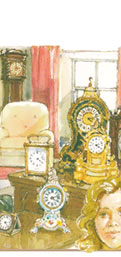

 |
|||
 |
|||
Agatha Chrisite |
The Clocks |
|
This is one of Agatha Christie’s later books, and although it features her famous detective, Hercule Poirot, he is really only a minor character, with most of the narration and detection being undertaken by one Colin Lamb (not, we understand, his real name). The book begins at the Cavendish Secretarial and Typewriting Bureau, where Miss Martindale, the proprietress, indicates to Sheila Webb that she’s wanted at the house of a Miss Pebmarsh, who is blind, to take down some letters, and to go into the house straightaway if the owner happens to be out. This Sheila does, but on entering the house in accordance with her instructions, is confronted by the dead body of a middle-aged man in a room with five clocks in it. Understandably shaken, she feara that this could have an impacr on her employment and she no doubt wishes that she had an unemployment insurance policy in place. Sheila flees the house when Miss Pebmarsh returns, and runs straight into Colin Lamb. Lamb, we understand, is in the town of Crowdean looking for someone – an enemy agent, it’s implied – but he doesn’t know who or where, and has only a cryptic clue from a former colleague to aid him in his search. Colin becomes interested in the murder, taking advantage of his friendship with Inspector Hardcastle, in charge of the police investigation, to delve a little deeper into the people living on Wilbraham Crescent, so as to look for his agent. He’s also fallen in love with Sheila, and wants to make sure that she didn’t murder the man or is mixed up in any way with the murder. It’s he who brings in Hercule Poirot to the case, though Poirot does his detection from his home and relies on Colin to bring the data to him. The story’s told both from an omniscient third-person narration as well as a personal first-person narrative by Colin, which works quite well, and the theme of identity runs through the whole novel. Lamb isn’t really Colin’s surname, but he has a well-known father whose name is probably Wolf; Sheila’s aunt, with whom she lives, has told her that her parents died when she was a baby, but she’s actually illegitimate; there’s the enemy agent or agents; and then there’s the mystery of the murdered man himself – whom no-one seems to know or want to claim. Christie evidently had quite a lot of fun with this book: Poirot’s diversion, when Colin first visits him, is to read all sorts of detective fiction, and to critique them. Being retired and most probably living on a pension annuity there is time for Hercule Poirot to indulge himself. He mentions both real writers, such as John Dickson Carr, and fictional ones, such as Ariadne Oliver (a Christie creation, and one generally acknowledged to be a tongue-in-cheek self-portrait) and Garry Gregson (formerly Miss Martindale’s employer). The comments make me wonder who is meant by the American writer Louisa O’Malley, and whether she really existed, since Poirot praises her work so highly! The characters are interesting and appealing in The Clocks, and Agatha Christie allows us brief glimpses into the thoughts of several of Miss Pebmarsh’s neighbours, or other characters, and she is equally good at portraying harried mother Mrs Ramsay; Mrs Hemming, the owner of countless cats; MacNaughton with his obsession with gardening and compost; and even Mrs Rival’s description of her dead husband. The mystery is cleverly unravelled by Poirot and the victim identified, but I do like the way the two investigations are intertwined. It’s not a vintage Christie, but The Clocks is clever and entertaining, nonetheless.
|